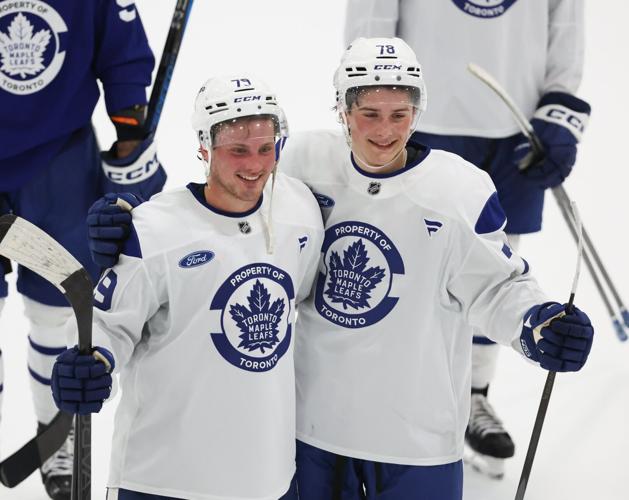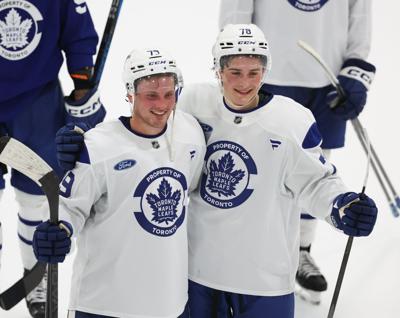Nick Moldenhauer went 20th overall to the Ottawa 67s in the OHL priority selection draft in 2020.
He never reported.
At 16 years of age, the forward from Mississauga was forced to make a major life decision: Play major junior hockey or play in a lesser league to maintain his amateur status and NCAA eligibility.
ŌĆ£Being an Ontario boy, if I could have played in the OHL and then and gone to school after, I think I probably would have done that,ŌĆØ Moldenhauer said.
He didn’t have that choice, though, and chose the U.S college route. He played for the Chicago Steel of the USHL to maintain his NCAA eligibility, and played well enough to be drafted in the third round of the 2022 NHL draft by the Maple Leafs. Then he headed to the University of Michigan.
After a summer that has included his third Leafs development camp,┬ĀMoldenhauer will head back to the Wolverines and a roster bolstered by the first wave of college-aged players from the Canadian Hockey League.
ŌĆ£It’s going to be an adjustment,ŌĆØ he said. ŌĆ£Looking forward to meeting everyone and seeing how they fit in on the ice and in the room.ŌĆØ
Gavin McKenna’s long-rumoured move to the NCAA is official.
Among Moldenhauer’s new teammates:
- Left winger Malcolm Spence, drafted in the second round in June by the New York Rangers, will leave the Erie Otters.
- Defenceman Henry Mews, a Calgary Flames third-rounder in 2024, is skipping his final year of junior with Sudbury. At 19, he is still ineligible to play in the AHL, so Division 1 is a bigger challenge for him.
- Matthew Mania, a Los Angeles Kings pick in 2023, is leaving the Flint Firebirds.
- Undrafted left winger Justin Larose is leaving the QMJHL because his junior career is over. A player like him previously might have ended up at Canadian university hockey program where the quality of the game isn’t quite as high as a U.S. Division 1 school.
Departures like this are happening across the CHL because of changes essentially forced on the NCAA by lawsuits that argued American college rules on amateurism were outdated and draconian.
ŌĆ£Ultimately, this is going to improve the quality of hockey. It’s going to improve the quality of our league tremendously,ŌĆØ┬ĀOHL commissioner Bryan Crawford said, adding the NCAA also will be better with the addition of CHL players.
ŌĆ£Having players who maybe weren’t ready for the NHL have a chance to prolong their development window in the NCAA, that’s going to raise the quality. That ultimately is going to raise the quality of the NHL. To me, it’s better for the families and the players. It’s better for hockey as a whole.
“But it’s a change that’s going to have ripple effects through all of the levels of hockey.ŌĆØ
The Penn State-bound McKenna is not alone. HeŌĆÖs part of a wave of players capitalizing on a new,
The biggest ripple? Gavin McKenna, a left winger widely expected to be the top pick of the 2026 NHL draft, announced this week he’s leaving the Medicine Hat Tigers for Penn State.┬ĀMcKenna is reportedly being paid $700,000 (U.S.), though both the dollar figure and the source of the money are not confirmed.
McKenna, like Auston Matthews going to Switzerland to play pro at 17, is somewhat of an outlier based on his elite talent level. Still, there are some financial incentives for Canadian athletes in any sport to choose the American college system.
As of July 1, schools have been able to share revenue, up to $20.5 million, with their student athletes. The caveat: Not all schools have that big a budget, and schools aren’t required to share.┬Ā
For hockey players at Division 1 schools, rosters are capped at 26, and schools are allowed to offer full scholarships to every player on the team (or as many as the budget will allow). There had been scholarship limitations and financial caps before.
There is a third revenue stream, available since 2021, that largely benefits American-born football and basketball players. Athletes can lend their name, image and likeness (NIL) to companies for endorsements or video games. College hockey players are not typically in demand for that revenue stream, and Canadians studying in the U.S. would have to check the terms of their student visas before going down that road (though they would be free to pursue NIL deals in Canada).
It’s believed the colleges have found a workaround for hockey players, which may include being paid by Canadian companies, which is one theory about how Penn State lured McKenna.
The biggest reason for the migration of older junior players to the NCAA is the quality of competition, especially for an 18-year-old who sees himself in the NHL one day, said Sean Hogan, executive director of College Hockey Inc., a non-profit organization that promotes U.S. college hockey.
Despite a rugged reputation as NHLers, Mark and Dale Hunter say they value speed, skill and
ŌĆ£When you’re 18 years old, (you think) you’re an NHL player,” he said. “In college, you have an opportunity to play against 23-, 24-, 25-year-olds. Grown men are preparing you to play against grown men at that next level. You won’t really have that opportunity in junior hockey. As you get to 18, 19, even 20 years old in junior hockey, you’re playing against 16- or 17-year-olds. And that’s a big difference in terms of game speed and preparing you for that next level.ŌĆØ
The pace of the season is also different. A college regular season is typically fewer than 40 games, with an emphasis on practice and skill development. The playoffs are short, with the champion crowned by early April. The OHL season is 68 games, with four best-of-seven rounds in the playoffs and, for the league champion, a trip in mid-May to the Memorial Cup.
Despite the losses of talent to U.S. colleges, the CHL isn’t panicking. It just had 21 players selected in the first round of the NHL draft and the league doesn’t expect that number to drop, especially with the top 16-year-olds now all able to play in the CHL without losing their college eligibility.
ŌĆ£We certainly gained a number of top players from other leagues,ŌĆØ Crawford said. ŌĆ£We’re definitely in a much more enviable position in terms of attracting those players that had chosen to go a different pathway.
ŌĆ£We are the best development environment in the world for 16- to 19-year-olds. The challenge for us is really to make sure that we continue to be progressive and proactive and we maintain that standing, that we don’t rest on our laurels.ŌĆØ
Crawford didn’t think there’d be a lot of draft-eligible players like McKenna leaving the CHL for a U.S. colleges.
ŌĆ£An elite player like Gavin McKenna is going to be successful anywhere,ŌĆØ Crawford said. ŌĆ£But for the vast majority of players, going to the NCAA is not going to mean top-line minutes. It’s not going to mean special-teams time. And that’s not necessarily the best development environment for a player who has aspirations of playing at the next level.ŌĆØ
Plus, Crawford said, the post-secondary scholarship money that is available to anyone who played in the CHL can be used toward a U.S. college.
Hogan sees another advantage to the college system changes.
ŌĆ£This is very good for college hockey, but I think it’s better overall for the landscape of hockey,ŌĆØ he said. ŌĆ£One of the biggest challenges we have in hockey you don’t see in other sports. We ask 15- and 16-year-old kids to move all over North America to pursue their sport. You don’t see that in American football. Kids play at home. They play for their high schools.ŌĆØ
Moldenhauer left Canada to play in the USHL. Now kids can stay closer to home until they’re ready for college.
ŌĆ£The more that we can have a straight line for the player-development path, I think the better it is for hockey overall,ŌĆØ Hogan said.


































To join the conversation set a first and last name in your user profile.
Sign in or register for free to join the Conversation